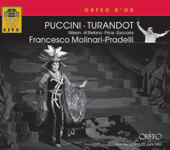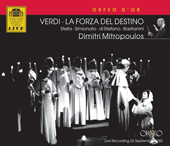Giuseppe Di Stefano
Born into a poor family at Motta Sant’Anastasia near Catania in Sicily, Giuseppe Di Stefano entered a seminary in 1934. After three years, a fellow student encouraged him to take singing lessons and he subsequently became a pupil of Luigi Montesanto and Mariano Stabile, who emphasized the importance of clear diction. In 1938 Di Stefano won a singing competition in Florence but his career was interrupted briefly by the outbreak of war in 1939. He was conscripted into the Italian army, but being seen as of greater value as a singer than a soldier, he was discharged and earned a precarious living as a singer of popular songs in Milan, performing under the name of Nino Florio. Following the German defeat in Italy, Di Stefano escaped to Switzerland, where he was briefly interned before being taken up as a tenor by Radio Lausanne. Here his repertoire extended from popular songs to complete operas.
After the end of the war, Di Stefano returned to Italy and made his official stage debut in 1946 at Reggio Emilia as Des Grieux in Massenet’s Manon. In 1947 he took the same role at La Scala, Milan, where he enjoyed immediate success. His American debut came in 1948 as the Duke in Rigoletto at the Metropolitan Opera House, New York and was quickly followed by appearances in Rio de Janeiro, Mexico City, Los Angeles, San Francisco and Chicago.
Di Stefano soon became one of the most sought-after tenors of his generation. Until 1953 he sang lighter roles, such as Elvino / La sonnambula, Fritz / L’amico Fritz, Nadir / Les Pêcheurs des Perles and Wilhelm Meister / Mignon; with these he enjoyed great success as a result of his warm tone, expressive phrasing and lively personality. His singing of traditional Neapolitan songs also demonstrated his talents superbly. During the early 1950s he was a favourite singer at La Scala and the Met, although his cavalier attitude towards contracts caused him to be barred from the latter by Rudolf Bing between April 1952 and December 1955.
For Walter Legge and the UK Columbia label Di Stefano took part in numerous recordings made with the forces of La Scala. The most famous of these was Puccini’s Tosca, conducted by Victor De Sabata, with Maria Callas and Tito Gobbi (with both of whom Di Stefano sang frequently). Other distinguished recorded assumptions from this period included the Duke and Arturo / I puritani, both again with Callas, conducted by Tullio Serafin.
By 1957 Di Stefano had added Canio / Pagliacci, Don Alvaro / La forza del destino, Don José / Carmen, Osaka / Iris, Radamès / Aida and Turiddù / Cavalleria rusticana to his repertoire. He made his British debut in 1957 as a member of the La Scala ensemble that visited the Edinburgh Festival, singing one of his most famous roles, Nemorino / L’elisir d’amore (a part he also recorded for Decca). In the same year he and Callas opened the 1957–1958 season at La Scala with an account of Un ballo in maschera which is one of the most intense ever to have been committed to disc, officially or unofficially. The assumption of heavier parts during the latter part of the 1950s, however, caused Di Stefano’s singing to become more effortful; and by the time of his 1961 first appearance at the Royal Opera House, Covent Garden (in Tosca), time and good living had also begun to take their toll, exposing technical weaknesses in his voice-production.
Di Stefano’s last appearance at La Scala was in 1972 with Carmen, after which he undertook some less than wholly successful recitals with Callas. He made his final stage appearance with the Rome Opera in 1992 as the Emperor Altoum in Turandot.
In addition to his operatic repertoire, Di Stefano was a highly accomplished singer of lighter music. He enjoyed success in operetta, recording the role of Prince Sou-Chong in highlights from Lehár’s Das Land des Lächelns with the forces of the Volksoper in Vienna.
Despite his personal unpredictability, Di Stefano at his best ideally matched tonal warmth with dramatic conviction, and his many studio and live recordings represent a remarkable testimony to his art.
© Naxos Rights International Ltd. — David Patmore (A–Z of Singers, Naxos 8.558097-100).


















